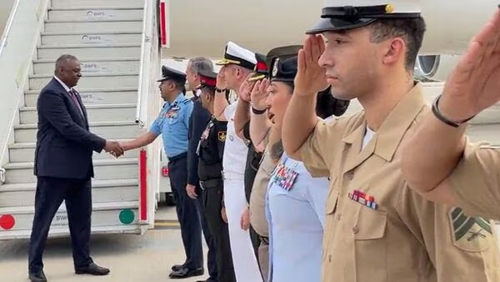US Defence Secretary in India, to hold talks with Rajnath today

STATE TIMES NEWS
New Delhi: US Defence Secretary Lloyd Austin arrived in India on Sunday on a two-day visit to explore ways to further strengthen bilateral defence cooperation, especially in areas of transfer of critical technologies for co-development of military hardware.
Secretary Austin’s trip comes over two weeks ahead of Prime Minister Narendra Modi’s state visit to Washington during which the two sides are expected to unveil initiatives to expand the India-US global strategic partnership.
“I’m returning to India to meet with key leaders for discussions about strengthening our Major Defense Partnership. Together, we’re advancing a shared vision for a free and open Indo-Pacific,” the US defence secretary tweeted shortly after landing in New Delhi.
Defence Minister Rajnath Singh and Austin are set to discuss in their talks on Monday General Electric’s proposal to share technology with India for fighter jet engines and New Delhi’s plan to procure 30 MQ-9B armed drones at a cost of over USD 3 billion from US defence major General Atomics Aeronautical Systems Inc besides other issues, people familiar with the matter said.
India has been looking at manufacturing of jet engines in India under the framework of technology transfer to power its fighter aircraft. In June 2016, the US designated India a “Major Defence Partner” paving the way for sharing of critical military equipment and technology.
China’s aggressive behaviour in the Indo-Pacific as well as along the Line of Actual Control and ways to combat the threat of terrorism are also likely to figure in the discussions between Singh and Austin.
The US Defence Secretary arrived from Singapore. It is Secretary Austin’s second visit to India. His previous trip to India was in March 2021.
In his address at the Shangri-La Dialogue in Singapore on Friday, the US defence secretary said, “Our Initiative on Critical and Emerging Technology with India lets us explore new ways to co-develop key defence platforms.”
Austin said the US is “stepping up planning, and coordination, and training with our friends from the East China Sea to the South China Sea to the Indian Ocean.”
“That includes staunch allies such as Australia, Japan, the Republic of Korea, the Philippines, and Thailand. And it includes as well such valued partners as India, Indonesia, Vietnam, and clearly our hosts here today in Singapore,” he said.
In a major move, President Joe Biden and Prime Minister Modi announced in May last year that the US-India initiative on Critical and Emerging Technology (iCET) to elevate and expand the strategic technology partnership and defence industrial cooperation between the two countries.
The iCET is expected to forge closer linkages between the government, academia and industry of the two countries in areas such as artificial intelligence, quantum computing, 5G and 6G, biotech, space and semiconductors.
On Saturday, Austin tweeted that he was deeply saddened by the train accident in Balasore.
“Deeply saddened to hear of the tragedy in Balasore. Our hearts go out to our partners in India. I will convey our condolences in person when I meet with senior leaders in India in the coming days,” he said.
Replying to the tweet, Singh said: “Deeply touched by your condolences. Thanks for your support. Looking forward to meet you tomorrow.”
The India-US defence and strategic ties have been on an upswing in the last few years.
The two countries have inked key defence and security pacts over the past few years, including the Logistics Exchange Memorandum of Agreement (LEMOA) in 2016 that allows their militaries to use each other’s bases for repair and replenishment of supplies.
The two sides also signed COMCASA (Communications Compatibility and Security Agreement) in 2018 which provides for interoperability between the two militaries and provides for the sale of high-end technology from the US to India.
In October 2020, India and the US sealed the BECA (Basic Exchange and Cooperation Agreement) agreement to further boost bilateral defence ties. The pact provides for sharing of high-end military technology, logistics and geospatial maps between the two countries.
